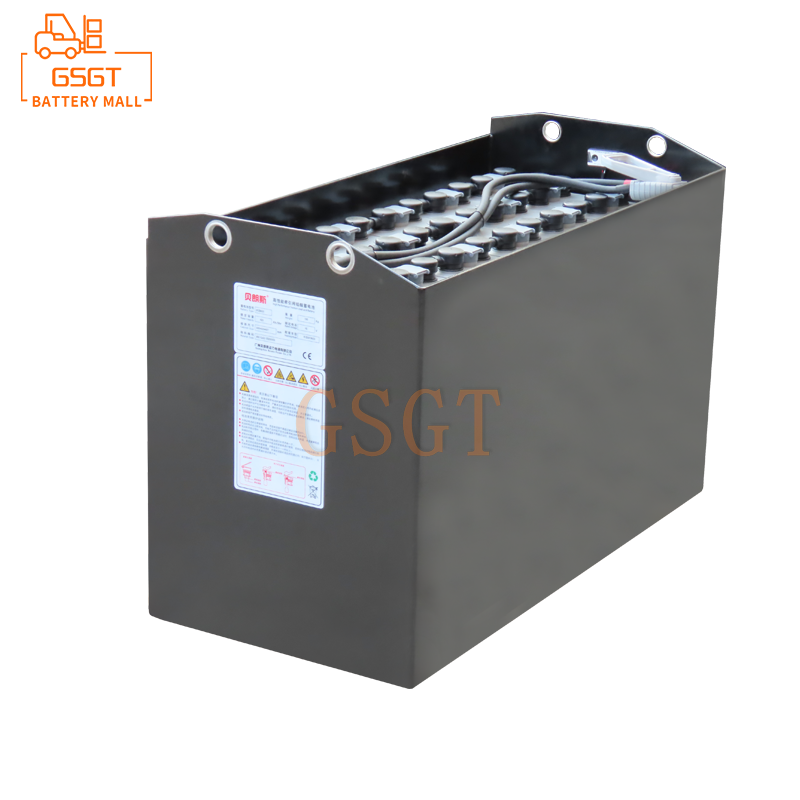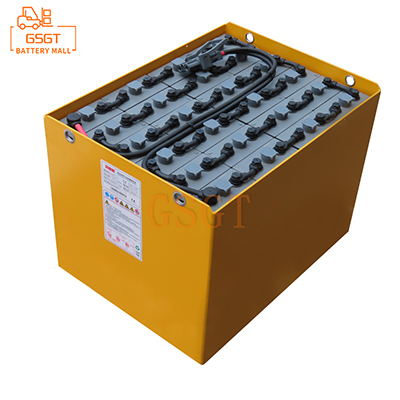Time:2025-04-02 15:48:56
Browse:563
In the field of industrial logistics, forklift as the main force of cargo handling, its power source is crucial. Lead-acid battery with low cost, mature technology, high current discharge performance and other advantages, become a common power supply for forklift. Understanding lead-acid batteries for forklifts, starting from model identification and extending to the entire use process, is of great significance for ensuring efficient operation of forklifts and extending battery life.
1, model identification: decode the battery "identity information"
The type of lead-acid battery used in forklifts usually consists of several parts, each of which contains specific information. Taking the common model "24-6DB 600" as an example, "24" means that the battery is formed by 24 single-cell batteries in series, and the nominal voltage of each single-cell battery is 2V, so the total nominal voltage of the battery is 48V. "DB" indicates the battery type, here is the British BS standard series traction battery, different letters correspond to different application scenarios.
In the selection, it is necessary to comprehensively consider the working intensity and running time of the forklift. Forklifts with frequent use and long working time should choose batteries with large capacity and stable performance; For scenarios requiring high maintenance convenience, maintenance-free batteries can be given priority.
2, before use: installation and inspection points
After the new battery arrives, the installation process cannot be underestimated. First of all, ensure that the installation location is clean and dry, away from fire and heat sources, to avoid battery damage due to environmental factors in use. During installation, ensure that cables are correctly connected according to the positive and negative electrode labels, and the wiring terminals are firmly tightened to prevent spark or excessive voltage drop caused by poor contact. After connecting the battery strings, check whether the batteries are tightly connected and whether they are damaged or leaking.
Before first use, for non-maintenance-free batteries, a standard electrolyte should be added. The electrolyte is usually formulated from sulfuric acid and distilled water in a specific ratio, and its density is usually between 1.28 and 1.30g/cm³, depending on the type of battery. When adding the electrolyte, control the liquid level between the upper and lower limits. Too much electrolyte may overflow and corrode the device, while too little will affect the battery performance. After adding liquid, it is necessary to stand for a certain time to let the electrolyte fully penetrate the plate, and then the initial charge. The initial charging should use a small current for a long time, the charging time is generally 10-15 hours, so that the battery plate is fully activated, laying the foundation for subsequent normal use.
3. In use: Charging and maintenance strategy
(1) Charge management
The charging process of lead-acid battery of forklift truck directly affects its service life and performance. When charging, choose a charger that matches the battery specifications to avoid overcharging or undercharging. When the battery power is reduced to 20%-30% of the rated capacity, it should be charged in time, and excessive discharge will vulcanize the plate and shorten the battery life. Common charging methods are constant current charging and constant voltage charging. At the beginning of constant current charging, constant current charging can be quickly replenished; Later to constant voltage charging, to prevent the battery overcharge. In general, the charging voltage should be controlled between 2.4-2.5V of a single cell battery, and the charging current should not exceed 0.15 times the battery capacity.
During the charging process, pay close attention to the battery temperature. When the temperature exceeds 45 ° C, the charging current should be reduced or the charging should be temporarily stopped, and the temperature should be cooled before continuing to prevent the battery from accelerating water loss and plate aging due to high temperature. At the same time, the charging place should be kept well ventilated, because the battery will produce hydrogen during the charging process, and the accumulation of open fire is easy to cause an explosion.
(2) Routine maintenance
Daily maintenance is the key to ensure the long-term stable operation of the battery. Before using the forklift every time, check the battery appearance to see whether there is leakage or bulging. If any abnormality is found, stop using the forklift immediately and find the cause. Clean the battery surface regularly to prevent short circuit caused by accumulation of dust and acid. Wipe the battery case with a damp cloth, but do not use organic solvents.
Check the electrolyte level regularly. For maintenance-free batteries, although there is no need to add the electrolyte frequently, it is still necessary to pay attention to the liquid level change. If the liquid level is too low, distilled water needs to be added. For non-maintenance-free batteries, in addition to supplementing distilled water, the electrolyte density needs to be regularly tested and adjusted according to the season and use. In winter, the electrolyte density can be adjusted to 1.28-1.30g /cm³ to enhance the low-temperature performance of the battery.
In addition, regular balanced charging of the battery is also important. Due to the differences in the characteristics of each battery in the battery pack, there will be inconsistent voltage after long-term use, balanced charging can make the battery voltage and capacity tend to be consistent, and extend the service life of the entire battery pack. Generally, a balanced charge is carried out every 2-3 months, and the charging time is 1-2 hours longer than the normal charging.
4. After use: proper storage and disposal
If the forklift is not used for a long time, store the batteries properly. First fully charge the battery, and then supplement the charge every half month to prevent the battery from self-discharging and resulting in loss of power. The storage environment should be kept dry and cool.
When the battery reaches its service life and cannot meet the normal working needs of the forklift, it should be scrapped. Lead-acid batteries contain harmful substances such as heavy metals lead and sulfuric acid. Discarding them will cause serious pollution to the environment. End-of-life batteries should be handled by professional recycling institutions, who have professional equipment and technology to recycle lead and sulfuric acid in batteries, realize resource recycling, and reduce the risk of environmental pollution.
Every link from model identification to use of lead-acid batteries for forklifts is related to their performance and life. Only by fully mastering these professional knowledge and operating in strict accordance with the specifications can the battery play its best role in the operation of the forklift truck, while reducing the cost of use, and providing reliable power support for the efficient operation of industrial logistics.

$1105

$2450

$3810

$3405

MESSAGE
Professional And Efficient
Security
Affordable Price
Professional Services